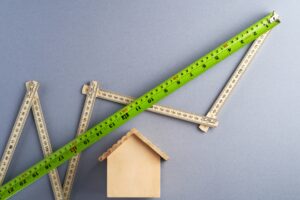Flipping houses can be exciting and stressful at the same time, particularly when dealing with a very tight budget. One tip that comes in handy for seasoned real estate investors is the “70% rule”. This allows setting a maximum purchase price that will still leave room for profit. More specifically, investors should not exceed 70% of a property’s after-repair value (ARV) minus the expected renovation cost. This rule mitigates risks and expenditures by offsetting unanticipated costs and recessions. Anyone wishing to excel in the fix and flip business must learn this strategy.
How Flipping Houses Works
A house flip is a targeted real estate investment strategy where funds are used to buy a property, do some renovations, and then sell it off quickly to make profits. This differs from the more traditional style of real estate investment – purchasing a property to earn rental income cash flows, since this primary focus is on reselling.
The art of successful flipping lies mainly in two approaches: making improvements on a property’s value or taking advantage of market value increase in rapidly developing areas.
Let’s say an investor buys a house in a developing neighborhood for 300,000.If the investor spends another 50,000 on renovations to sell the house for 400,000, the investor makes a profit of 50,000, and that is excluding extra expenses such as taxes or holding costs.
The investor is highly motivated to sell the house as fast as possible because each day the investor waits, he incurs unwanted utility, mortgage and maintenance costs. In this case, the calculated flipper focuses on speed rather than waiting for the best possible offer.
Importance of Market Appreciation and Renovations
The estimated profit from a fix-and-flip project is primarily dependent on market appreciation and renovations that strategically increase the value of the property. Flippers focus on older properties located in upcoming areas surrounded by growth, as there is a potential for new opportunities, and they focus on renovations that enhance functionality and aesthetics.
Enhancing property value is often a result of market dynamics; however, controlled renovations that the investor makes tailors the property to heightened demands or specific requirements by the buyers, further increasing the selling price. Wise investors recognize that renovating a property in alignment with current market trends is the best way to ensure a profitable return on investment.
Speed vs. Profit: Balancing the Equation
When it comes to the flipping process, one of the most pressing issues is striking the right balance between speed and profit optimization. While it is always great to achieve the highest possible resale value, flippers tend to lean toward having a faster turnaround on sales. However, selling too quickly can lead to lost investment opportunities.
To cope with this challenge, seasoned investors seek a middle ground that both ensures sufficient profit and speed. This method not only requires carefully designed buying and renovation plans but also extraordinary project control to make sure that all properties are ready for sale in the minimum time possible.
Identifying the Right Property
Finding the right property is the foundation of profitable flipping ventures. In order to maximize the benefits of each flip, the buy price, the location, and the scale of renovation work needs to be aligned.
Using the 70% Rule for Purchase Price
When considering the purchase price, a lot of flippers suggest the 70 Percent Rule, which says that no more than 70 percent of the after repair value (ARV) should be spent. As the name suggests, ARV is the estimated value the property will fetch in the market after renovation.
With these considerations, if a pre flipped property has an ARV set at 300,000 and it requires an additional 50,000 in repairs, an investor should not be paying more than 160,000. This rule brings forth matters of estimation and understanding the wider market deeply.
Evaluating Location and Potential for Growth
Flipping properties in the right location is critical in making meaningful profits. The research should focus on schools, local jobs, and infrastructure construction to identify emerging neighborhoods. High-growth areas usually have low crime rates and are coupled with good amenities and tend to be developed further in the future.
An investor who strategically picks the regions where growth is predicted stands a greater chance of making a profit. Using the help of a local real estate agent and analyzing the census would be greatly beneficial.
Conducting a Thorough Property Inspection
Purchasing property without prior inspection is an oversight. Failure to inspect the property might hinder renovation objectives because it uncovers underlying issues. The property’s foundation, roof, plumbing, and electrical systems must be carefully inspected.
The identified weaknesses help in creating better negotiating strategies and help work within acceptable costs. Such effort makes estimating time and actions plausible to ensure modest expectations arise when acquiring the property analyzed.
Essential Skills and Resources
As for fix and flip properties, possessing some specific skills and knowledge can increase your chances of success significantly. Let’s discuss them in detail!
Financial Planning and Managing Costs
A critical skill when flipping properties is the ability to construct a tangible cost-effective financial plan as well as manage costs. In real estate, expenditures start with the acquisition which is the price of the property. A home comes at a price, and its renovation in addition to Holding costs, which accumulate when the home is not selling, also adds to the price. The same goes for investors, who need to estimate the carrying costs, which include property taxes, insurance, utilities, and other associated costs.
In the industry, controlling expenses is very important, especially for property investors. Investors must anticipate unforeseen shifts in the market, measuring demand, reservations, altering, and competencies in order to ensure profitability. Advanced tools and planning software are used nowadays by construction planning and projecting engineers equipped with mortgage comparison calculators, seeking deals beyond the best lending conditions.
Time Management and Coordination
Time management is yet another skill necessary for success in property flipping. It is not a leisure activity for weekend warriors. Finding the right property can take anywhere from four to six months and often involves lengthy work hours and dedicated effort with few breaks.
With all these aspects in place, meeting all the obligations becomes the most challenging aspect of the work. Managing multiple obligations within this framework requires impressive balance, and a lack of too little can be incredibly destructive towards one’s finances, personal life, or schedule.
Building a Reliable Network of Contractors
When dealing with investors who are not physically managing the renovations, a dependable contractor network must be created. Plumbing, carpentry, and electrical trades must and, at a bare minimum, be of standard quality. Otherwise, timelines, deadlines, and budgets will be compromised.
If a person possesses both the skill and time to do the renovations, they can make use of sweat equity, but for everything else, the right professionals must be obtained. The cultivated network of contractors seeks profits while attempting to meet all renovation goals and objectives, minimize the chances of underperformance, and avoid a construction standards disaster.
Common Mistakes to Avoid
While flipping properties, knowing how to identify and avoid mistakes is essential in ensuring profits.
- Under Financing: Without accurate budgeting, the project may overspend or debt sink, leading to losses. Every cost needs to be accounted for, including surprise buffers well ahead of time.
- Underestimating Time: Between a full-time job and house flipping, schedules can get very tight and require reliable subcontractors. If your timeline doesn’t permit extra management tasks, consider bringing on a trustworthy general contractor.
- Lack of Knowledge: Having the most up to date knowledge on the real estate field and zoning areas as well as construction order of priority is an important factor. People who want to make quick cash without knowledge can lead themselves into financial debt.
- Impatience: Waiting for the right opportunity to buy the best house comes with phenomenal patience. If you lose your calm and start hurrying, expect to drastically decrease value on acquisition and have massive overspending on renovation.
Conclusion
As stated above, flipping properties is rewarding but only if there is a strategy and finances in place. Having sensible goals is equally important to finances. Success is largely dependent on the initial investment made and in this case, using the 70% rule is a smart decision. Also note that all expenses, including the cost of holding the property and renovations, need to be evaluated. A strong market with a sound financial investment alleviates risks and maximizes rewards, which is crucial when investing in real estate.
Equally important are time, patience, and one’s skill set. Flipping takes time. It requires excellent project management, as well as anticipating possible setbacks. Renovations need to be done cost effectively and strategic thought based on the local market, whether personally managed or through contractors, is non-negotiable. Well-calculated plans coupled with sound judgment are needed to distinguish desperate mistakes from profitable flips.
FAQs
Do I need to have a cash offer to flip a house?
A cash offer isn’t a requirement to flip a house, even though 63% of house flips are bought with cash. Various means of financing are available, and many successful flippers leverage financing of distinct types for their projects.
How long does it take to flip a house?
The average time frame to complete the buying and selling process takes about four to six months. This timeline is much longer for novice house flippers until they become accustomed to the practice and streamline their process.
What is the formula for flipping houses?
The 70% rule states that successful house flippers only purchase properties if the investment will exceed the value of the repairs. It is a quick calculation tool to evaluate a property for an investment. According to this rule, no one should spend more than 70% of the Expected After Repair Value (ARV) minus the cost incurred in repairs.





